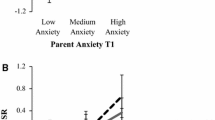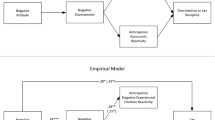Abstract
This study examined the associations between maternal anxiety, behaviors, and expectations and children’s self-evaluations of distress, coping, and performance during a stressful performance evaluation task. Seventy-five mothers (38 clinically anxious and 37 nonanxious) along with one of their children aged 6–14 (52.0% female; 78.7% Caucasian) were videotaped while preparing the child to deliver a speech about themselves. Child and parent assessments were obtained before and after the speech, and independent coders rated maternal behavior during the speech preparation. Maternal anxiety and behaviors accounted for a greater proportion of variance in children’s self-evaluations than did maternal expectations, such that children of mothers who reported higher task anxiety and demonstrated more overcontrol and anxious behavior during the task evaluated themselves more negatively. These findings extend the literature by providing information about the relative associations between maternal factors and children’s self-evaluations within the context of an in vivo stressful situation.
Similar content being viewed by others
References
Beidel D, Turner S (1997) At risk for anxiety: I. Psychopathology in the offspring of anxious parents. J Am Acad Child Adolesc Psychiatry 37:918–924
Last C, Hersen M, Kazdin A, Francis G, Grubb H (1987) Psychiatric illness in the mothers of anxious children. Am J Psychiatry 144:1580–1583
Schneider S, Unnewehr S, Florin I, Margraf J (2002) Priming panic interpretations in children of patients with panic disorder. J Anx Dis 16:605–624
Muris P, Field A (2010) The role of verbal threat information in the development of childhood fear. “Beware the jabberwock!”. Clin Child Fam Psychol Rev 13:129–150
Askew C, Field A (2008) The vicarious learning pathway to fear 40 years on. Clin Psychol Rev 28:1249–1265
Rachman S (1977) The conditioning theory of fear acquisition: a critical examination. Behav Res Ther 15:375–387
Bandura A (1986) Social foundations of thought and action: a social cognitive theory. Prentice-Hall, Englewood Cliffs, NJ
Burstein M, Ginsburg G (2010) The effect of parental modeling of anxious behaviors and cognitions in school-aged children: an experimental pilot study. Behav Res Ther 48:506–515
Field A, Hamilton S, Knowles K, Plews E (2003) Fear information and social phobic beliefs in children: a prospective paradigm and preliminary results. Behav Res Ther 41:113–123
Gerull F, Rapee R (2002) Mother knows best: the effects of maternal modeling on the acquisition of fear and avoidance behaviour in toddlers. Behav Res Ther 40:279–287
Muris P, Bodden D, Merckelbach H, Ollendick T, King N (2003) Fear of the beast: a prospective study on the effects of negative information on childhood fear. Behav Res Ther 41:195–208
Ballash N, Pemble M, Usui W, Buckley A, Woodruff-Borden J (2006) Family functioning, perceived control, and anxiety: a meditational model. J Anx Dis 20:486–497
Becker KD, Ginsburg G, Domingues J, Tein J (2010) Maternal control behavior and locus of control: examining mechanisms in the relation between maternal anxiety disorders and anxiety symptomatology in children. J Abnorm Child Psychol 38:533–543
Chorpita B, Barlow D (1998) The development of anxiety disorders: the role of control in the early environment. Psychol Bull 124:3–21
Chorpita B, Brown T, Barlow D (1998) Perceived control as a mediator of family environment in etiological models of childhood anxiety. Behav Ther 29:457–476
Alloy L (2001) The developmental origins of cognitive vulnerability to depression: negative interpersonal context leads to personal vulnerability. Cog Ther Res 25:349–351
Cooley C (1902) Human nature and the social order. Scribner’s, New York
Cole D, Maxwell S, Martin J (1997) Reflected self-appraisals: strength and structure of the relation of teacher, peer, and parent ratings to children’s self-perceived competencies. J Edu Psychol 89:55–70
Turk E, Bry B (1992) Adolescents’ and parents’ explanatory styles and parents’ causal explanations about their adolescents. Cog Ther Res 16:349–357
Creswell C, O’Connor T, Brewin C (2006) A longitudinal investigation of maternal and child ‘anxious cognitions’. Cog Ther Res 30:135–147
Creswell C, Schniering C, Rapee R (2005) Threat interpretation in anxious children and their mothers: comparison with nonclinical children and the effects of treatment. Behav Res Ther 43:1375–1381
Kortlander E, Kendall P, Panichelli-Mindel S (1997) Maternal expectations and attributions about coping in anxious children. J Anx Dis 11:1–19
Micco J, Ehrenreich J (2008) Children’s interpretation and avoidant response biases in response to non-salient and salient situations: relationships with mothers’ threat perception and coping expectations. J Anx Dis 22:371–385
Barrett P, Rapee R, Dadds M, Ryan S (1996) Family enhancement of cognitive style in anxious and aggressive children. J Abnorm Child Psychol 24:187–203
Chorpita B, Albano A, Barlow D (1996) Cognitive processing in children: relation to anxiety and family influences. J Clin Child Psychol 25:170–176
Cobham V, Dadds M, Spence S (1999) Anxious children and their parents: what do they expect? J Clin Child Psychol 28:220–231
Moore P, Whaley S, Sigman M (2004) Interactions between mothers and children: impact of maternal and child anxiety. J Abnorm Psychol 113:471–476
Woodruff-Borden J, Morrow C, Bourland S, Cambron S (2002) The behavior of anxious parents: examining mechanisms of transmission of anxiety from parent to child. J Clin Child Adolesc Psychol 31:364–374
Costello E, Egger H, Angold A (2004) The developmental epidemiology of anxiety disorders. In: Ollendick R, March J (eds) Phobic and anxiety disorders in children and adolescents. Oxford University Press, New York, pp 61–91
Ginsburg G (2009) The child anxiety prevention study: intervention model and primary outcomes. J Consul Clin Psychol 77:580–587
Brown T, DiNardo P, Barlow D (1994) Anxiety disorders interview schedule for DSM-IV. Graywind Publications, New York
Silverman W, Albano A (1996) The anxiety disorders interview schedule for DSM-IV: child and parent versions. Psychological Corporation, San Antonio, TX
Shrout P, Fleiss J (1979) Intraclass correlations: uses in assessing rater reliability. Psychol Bull 86:420–428
Ginsburg G, Grover R, Ialongo N (2004) Parenting behaviors among anxious and non-anxious mothers: relation with concurrent and long-term child outcomes. Child Fam Behav Ther 26:23–41
Hudson J, Rapee R (2001) Parent-child interactions and anxiety disorders: an observational study. Behav Res Ther 39:1411–1427
Barrett P, Shortt A, Healy L (2002) Do parent and child behaviours differentiate families whose children have obsessive-compulsive disorder from other clinic and non-clinic families? J Child Psychol Psychiatry 43:597–607
West S, Finch J, Curran P (1995) Structural equation models with nonnormal variables: problems and remedies. In: Hoyle R (ed) Structural equation modeling: concepts, issues, and applications. Sage Publications, Thousand Oaks, CA, pp 56–75
Menard S (1995) Applied logistic regression analysis. Sage Publications, Thousand Oaks, CA
Ginsburg G, Schlossberg M (2002) Family-based treatment of childhood anxiety disorders. Int Rev Psychiatry 14:143–154
Lester K, Seal S, Nightingale Z, Field A (2010) Are children’s own interpretations of ambiguous situations based on how they perceive their mothers have interpreted ambiguous situations for them in the past? J Anx Dis 24:102–108
McLeod B, Wood J, Weisz J (2007) Examining the association between parenting and childhood anxiety: a meta-analysis. Clin Psychol Rev 27:155–172
Acknowledgments
This study was supported by a grant from the National Institute of Mental Health (MH63427-02) awarded to Golda S. Ginsburg, Ph.D. During manuscript preparation, Kimberly Becker was supported by the National Institute of Mental Health (T32 MH18834).
Author information
Authors and Affiliations
Corresponding author
Rights and permissions
About this article
Cite this article
Becker, K.D., Ginsburg, G.S. Maternal Anxiety, Behaviors, and Expectations During a Behavioral Task: Relation to Children’s Self-Evaluations. Child Psychiatry Hum Dev 42, 320–333 (2011). https://doi.org/10.1007/s10578-011-0216-7
Published:
Issue Date:
DOI: https://doi.org/10.1007/s10578-011-0216-7




